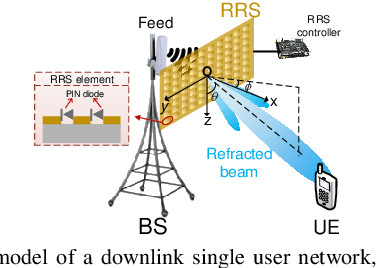Reconfigurable Refractive Surfaces: An Energy-Efficient Way to Holographic MIMO
Paper and Code
Jul 06, 2022

Holographic Multiple Input Multiple Output (HMIMO), which integrates massive antenna elements into a compact space to achieve a spatially continuous aperture, plays an important role in future wireless networks. With numerous antenna elements, it is hard to implement the HMIMO via phased arrays due to unacceptable power consumption. To address this issue, reconfigurable refractive surface (RRS) is an energy efficient enabler of HMIMO since the surface is free of expensive phase shifters. Unlike traditional metasurfaces working as passive relays, the RRS is used as transmit antennas, where the far-field approximation does not hold anymore, urging a new performance analysis framework. In this letter, we first derive the data rate of an RRS-based single-user downlink system, and then compare its power consumption with the phased array. Simulation results verify our analysis and show that the RRS is an energy-efficient way to HMIMO.
 Add to Chrome
Add to Chrome Add to Firefox
Add to Firefox Add to Edge
Add to Edge